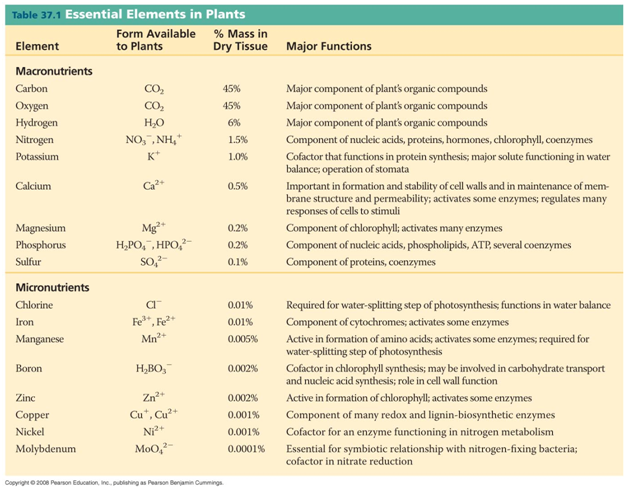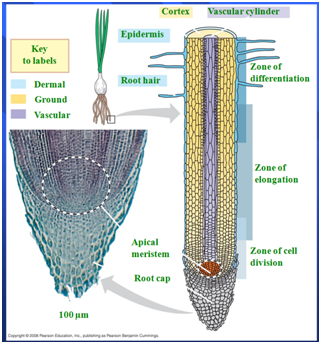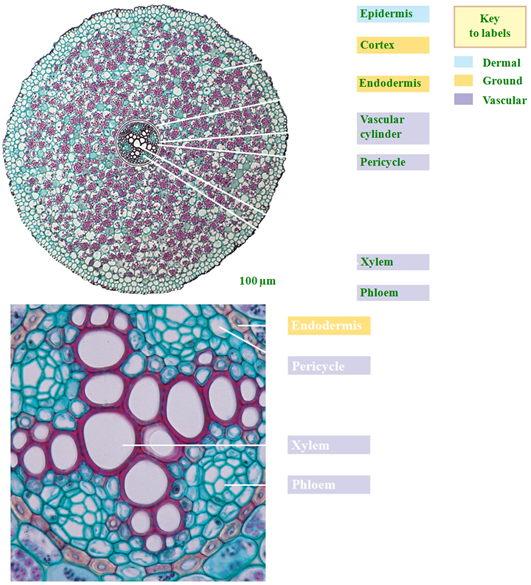Cards In This Set
| Front | Back |
|
Meristematic tissue- definition- location- process
|
the only tissue in a plant that retains the
ability to make new cells
in plants, there are specific areas that divide and once those cells are formed, they never divide again – usually located in just two places: 1) apical – apex = top / peak / tip; apical meristem – tissue at the ends of the branches and the roots that produce new cells – very tips of the shoots and very tips of the roots; plant get taller or roots get deeper; once those cells divide, they never divide again, only grow bigger; also how you get new branches 2) lateral meristem – what allow plants to increase in diameter, get wider; trees, bushes, anything that increases in diameter; tissue located around the sides / circumference of certain species - meristem cell divides à forms one new meristem cell and one new plant cell of some type à meristem cell continues to divide, while the plant cell is now permanent tissue à permanent tissue gets bigger while meristem continues to divide |
|
Permanent tissues - 3 major types
|
1) dermal2) ground3) vascular
|
|
Dermal
|
- dermal –
outermost layer
- epidermis – single cell layer
- periderm – much thicker, multilayer
structure that in some plants, some of the epidermis develops into; i.e. bark
(woody dicot)
|
|
Ground
|
- ground –
connective tissue – filling up space
- parenchyma (make up majority of the
leaf), collenchyma (similar to fatty, adipose tissue – storage in stems),
sclerenchyma (give very thick cell walls, strength, hold up plant)
- fairly undeveloped, simplistic cells
that are good at doing two major things: 1) filling spaces, 2) storing stuff;
- third function: primary
photosynthetic cells, have most of the chloroplasts in the leaves
|
|
Vascular
|
- vascular –
animal = arteries / veins / capillaries; transport tissues
- xylem – carry water and nutrients
dissolved in water from the soil, up the trunk, to the leaves; secondary
function of support; tend to function when they’re not alive; When they connect
to each other and then die, they produce these big pipes with holes in them so
that water flows very freely
- phloem – carry what the leaves make
(photosynthates – the result of photosynthesis), dissolved in water (plant sap)
down to the branches, trunks, stems, roots; function when they’re alive;
typically have companion cells help to control / regulate them; pretty much
just big pipes
|
|
Plant organs & organ systems
|
- plant
organs
- roots
- stems
- leaves
- reproductive units
- plant
organ systems
- shoot system – typically what’s above
the ground
- root system – typically what’s below
the ground
|
|
Roots function & location
|
- function:
how the plant gets the water and nutrients that are dissolved in the water;
absorbs; anchor and support plants from falling over
- vast
majority of roots of large plants are in the top 6 inches or so – because
that’s where the nutrients & water are; may have longer tap root for
anchoring & side roots for support; how massive it spreads out – anchors
them, not necessarily the depth
- storage –
that’s the material that the plant will use to grow the next year / season;
i.e. potatoes – the eyes start to bud and you can use it to plant the next year’s
crops – reservoir of starch;
|
|
Soil - definition & makeup
|
- soil: is
not dirt; the unconsolidated layer of
organic matter, inorganic matter, and pore space that covers the earth; all
3 become important to the make up to the soil; really good soil would be 5%
organic (come from decaying organisms, decomposition), 45% inorganic matter
(mostly from the rock in the area, rock breaks down / grinds down), 50% pore
space (holes – you don’t want the soil to be solid; some place for water to be;
25% = water – because you can’t overwater your plants – they die because plants
need oxygen; 25% air – plants need somewhere for roots to go); soil provides
water and nutrients
|
|
Soil minerals
|
- soil
minerals – nutrients in soil usually in form of minerals; usually the same
minerals that we need; BOOK CHART: move iron up to macronutrients; know the major
functions of macronutrients & micronutrients; nutrients are at the
elemental level – not like carbohydrates, triglycerides, etc.; broken down
into:
1) essential
– MUST be there; essential for life; if these are not there, plant or you will
die
- difference between macronutrients
& micronutrients = relative amounts that are needed; macro are needed in
relatively large quantities; micro are needed in relatively small quantities
- interesting thing is: if you have too
little OR too much will have problems & die
- micro vary a bit from cell to cell /
species to species; macro will almost always be those listed in book chart with
iron added
- macro: CHOPKiNS CaFe Mg (mighty good)
2)
non-essential – not necessary for survival, but they enhance growth, vigor,
life of organism; i.e. chocolate
|
|
Essential elements in plants
|
 Book chart |
|
Roots - longitudinal section / zones
|
 - Root cap – bunch of sacrificial cells (?) – irregular cells that protect the very important region of the apical meristem; the root is going through soil and that’s tough stuff; break off, die, be destroyed, get replaced;- Zone of cell division – immediately behind the root cap; this is where the apical meristem is found (meristem = only tissue that can divide); root tip going to get longer and longer and the reason it gets longer is because meristem cells are dividing – divide, making a new meristem cell and a permanent cell; both of them will grow and elongate and push the root further down into the soil; zone of cell division continually moves down; after they divide, those zones are replaced by the zone of elongation; after they divide and grow to their maximum length, they never divide or elongate again, and differentiate into functioning, permanent tissue à zone of differentiation aka zone of cell maturation aka zone of root hair; after maturation occurs, it’s no longer a zone, it’s just root - Advantage of root hair – greater surface area à helps anchor plant and absorb water and nutrients |
|
Two major types of angiosperms
|
1) monocot
2) eudicot
|
|
Eudicot root cross section
|
 Eudicot root: - epidermis – single cell layer that is covering the root - cortex – majority of the root; simple ground tissue - vascular cylinder – where all the vascular tissue is - in most species, xylem is in the shape of an X – all the big round cells that carry water up - in between the X’s, phloem – large tube like cells that carry food from the leaves down to the roots to keep the roots alive - endodermis – kind of like an inner dermis; single layer of cells around the vascular cylinder, most of which have thick, waxy layer – kind of like a band running down the middle running all the way around with gaps here and there – substance is called suberin (waxy layer is called the casparian strip) – wax is good at keep out water – designed to keep the water inside the vascular cylinder; openings that do not have suberin – passage cells, allow water to go through, but only few of them - pericycle – single layer of cells just inside the endodermis; type of meristem tissue; allow new lateral roots to form; when main root needs to make new roots on the side, pericycle starts reproducing and produces what eventually looks like a regular root; bursts out of the endodermis, goes through the cortex, comes out the epidermis and starts growing to the side like a normal root; kinnes thinks this is more meristem tissue than vascular tissue |
|
Monocot root cross section
|
- has all
the same layers as eudicot but organized differently
- epidermis,
cortex about the same
- larger
vascular cylinder – endodermis much further out, pericycle still within that
- xylem and
phloem are not organized as distinctly as in the dicot – clumps of xylem and in
between them, bunch of phloem; and in the middle, a bunch of ground tissue
(core of parenchyma cells) filling up space
|
|
Stems function
|
- main
component of the shoot system
- functions:
support; storage; transport; in very young plants (those that last only a year
or so), stem also can do photosynthesis (i.e. cactus don’t have leaves, their
stems do photosynthesis) – anything that’s green is capable of doing
photosynthesis
|



